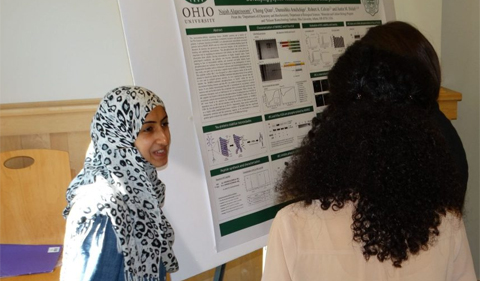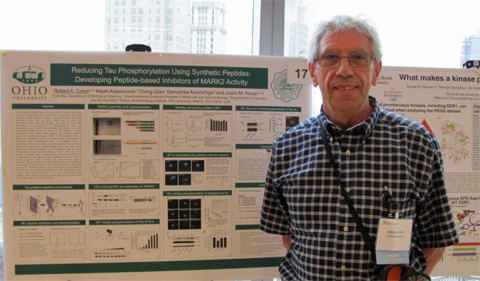
Najah Al Qaeisoom presenting her research on phosphorylation of the tau protein to students and faculty during Neuroscience Research Day (photo: Muhammad Fauzi)
By Amanda Biederman
Alzheimer’s disease is the most common neurodegenerative disease in the United States, yet the pathological basis of this disease is not yet fully understood. Doctoral chemistry student Najah Al Qaeisoom is working to understand one critical component of Alzheimer’s progression.
Working under the direction of Chemistry & Biochemistry professor Justin Holub, Al Qaeisoom is synthesizing peptides that may inhibit a certain kinase that is known to play an important role in Alzheimer’s progression. She recently won third prize for her work in the graduate student competition at Neuroscience Research Day, and her work was published in the International Journal of Peptide Research and Therapeutics earlier this year.
Kinases are a certain type of enzyme that are known to modify other molecules by phosphorylation. In Alzheimer’s disease, kinases phosphorylate tau, a type of protein that is known to aggregate during progression of this disease. Phosphorylation of tau protein is likely to play a role in the pathology of Alzheimer’s disease.
The tau protein is known to be phosphorylated at several distinct regions. For her project, Al Qaeisoom synthesized an artificial peptide molecule that mimics one of those regions. Working with Biological Sciences professor Dr. Robert Colvin and doctoral student Cheng Qian, Al Qaeisoom found that her peptide inhibits tau phosphorylation in cultured cells. In other words, when her peptide is introduced into the cell, the kinase phosphorylates the peptide. Consequently, this reduces the level of tau phosphorylation.
Ultimately, Al Qaeisoom’s findings may help other researchers design treatments for Alzheimer’s patients to slow progression of this disease. However, she said, more research will be needed before this type of treatment can be used in clinical studies.
“This has the potential to be a therapeutic,” she said. “I think for someone who wants to use this peptide, they will need to synthesize a library of the small molecules based on the active group or side chain of amino acids obtained from the sequence of the inhibitory peptide and test them.”
- Read Al Qaeisoom’s paper on “Inhibiting Phosphorylation of Tau (τ) Proteins at Ser262 Using Peptide-Based R1 Domain Mimetics.”



















Comments